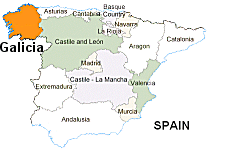The Celts
References
Galicia is not Spain... Because Galicia is not flamenco, bullfighting, tango and "ole". Galicia is a Celtic nation. Galicians are
not an Iberian people but a Celtic one. We don't like flamenco. We have our own dances and music. We profoundly dislike
bullfighting..
Celtic music from Galicia
Domingo Manfredi Cano states in his book "Geografica del Cante Jondo" that the port of Cádiz was an important stop-over point for ship
travelers of the past. These visitors brought the songs and dances with them, many of which were adopted by the people of Cádiz and converted
into flamenco. This, says Sr. Manfredi is what happened to the Farruca, which is nothing more than an Asturian dance strongly influenced by
the Tangos of Cádiz... There are two schools of thought concerning the origin of Garrotín. One states that is has taken the same road as the
Farruca.
The other school, led by Vicente Escudero, insists that the Garrotín is a creation of the gypsies of Lerida, in northern Spain. (If you
have a look at Sr. Pohren's Flamenco family tree chart on Page 102, you will notice that not only Faruca and Garrotín is placed under the
"Celtico" umbrella, but also Sevillanas and Fandango family of song forms.) The Art of Flamenco - D. E.
Pohren The Galicians are Celts, first cousins to the Irish, Welsh, Scots, Cornish and Bretons and used to speak a language of the same
family... They have many ancient customs in common with the Irish (their music sounds Irish too!) and the same laws of inheritance
Iberian Civilization - Anita Kelly, Ph. D.
|

GALICIA (anc. Gallaecia or Callaecia),
A autonomous region (also a Duchy of the Spanish Monarchy) of north west Spain, comprising the provinces of
La Coruna, Lugo, Orense, and Pontevedra. The capital is Santiago de Compostela . Most of the people speak Galician, a
language closely related to Portuguese with ancient roots to ancient Iberceltic and Latin. The region is mainly agricultural
with a large fishing and timber industry. Galicia was a Celtic kingdom from 411 to 585, and again in the 11th century after
the death of Ferdinand I King of Castile and Leon. It came under Spanish domination late in the 15th century. In 1833 it was
divided into its present provinces. Area 29,434 sq kin (11,364 sq mi), population (1991) 2,731,669. Strong Celtic Customs.
Language spoken : Galician and Spanish.
Modern lands of the Celts
|
| 


